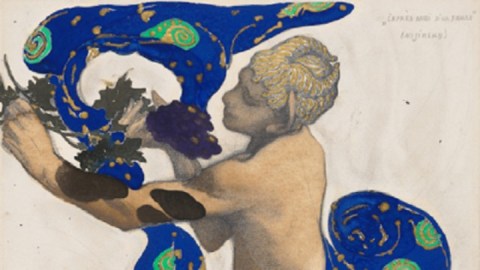When Modernism First Moved

Modernism first moved on May 29, 1913. That’s century-old hyperbole, of course, but if any date achieves day of infamy status for modern art in the 20th century, it’s the day that Russian composer Igor Stravinsky teamed up with Russian ballet impresario Sergei Diaghilev and his Ballets Russes company to stage Le Sacre du printemps, or, in English, The Rite of Spring. Diaghilev and the Ballets Russes, 1909–1929: When Art Danced with Music, now at the National Gallery of Art, Washington, DC, returns to that cataclysmic moment when modernism became an unavoidable reality for the mainstream public, which had done its level best to ignore it previously. Multimedia in its combination of music, dance, and artistic design, The Rite of Spring and other productions by the Ballet Russes helped modernism move beyond the fringe to the center of Western culture ever since.
Diaghilev’s twin interests in art and dance first brought those two worlds together on the modern stage. An internationalist in his tastes, Diaghilev longed to bring Russian art—especially the groundbreaking work of Stravinsky and his star dancer and choreographer Vaslav Nijinsky—to a wider, European audience. To his credit, Diaghilev possessed a great eye for finding kindred artistic spirits to collaborate with beyond Russian borders, including Pablo Picasso, Henri Matisse, Giorgio de Chirico, Jean Cocteau, Sonia Delaunay, Natalia Goncharova, and Georges Rouault, among others.
Goncharova’s backdrop for the production of The Firebird may be the largest single piece ever exhibited at the NGA. At the other end of the size scale, costume and set designer Léon Bakst created, among other amazing costumes, Nijinsky’s Faun costume (shown above) for The Afternoon of a Faun, which was performed a year before The Rite. Going even smaller, you can see sculptures and paintings documenting the growing cult of personality forming around the bisexual Nijinsky as not just the preeminent dancer of the time, but a revolutionary in terms of sexual politics. Auguste Rodin’s sculpture of Nijinsky as the Faun captures the raw power and overt sexuality of the dancer, while Eugène Druet’s photograph of the dancer mid-leap retains the sense of Nijinsky as a defier of both gravity and conventionality. When you think for a moment that Rodin saw Nijinsky dance in Bakst’s costume and probably talked about it with his friend Druet, who Rodin relied upon to photograph his sculptures at their most dramatic, you get a sense of just how deeply the Ballet Russes penetrated the interconnected art world at the time. Rodin and all those others thus passed on that modernist DNA via the dancers to us today.
As exciting as the art generated for or in response to the Ballet Russes is, the real stars of the show are the costumes. There’s just a vibe that comes off of the old costumes for ballets such as Boris Godunov, Narcissus, Scheherazade, Prince Igor, Daphnis and Chloe, and Les Sylphides (which served as a more acceptable warm-up to The Rite on that fateful opening night). Fascinating names such as Coco Chanel (The Blue Train, 1924), de Chirico (The Ball, 1929), and Sonia Delaunay (Cleopatra, 1918) all designed costumes for the Ballet Russes. Seeing the costumes for The Rite of Spring on mannequins allows you to imagine them in action, but Bakst’s illustrations for his costumes beautifully demonstrate how they moved, if not in real life, in the mind’s eye. The Met’s current fashion exhibit PUNK: Chaos to Couture(which I reviewed here) could learn a lesson from these original rabble rousers and their couture of chaos from a century ago.
Diaghilev died from diabetes in 1929, providing a neat closing date for Diaghilev and the Ballets Russes, 1909–1929: When Art Danced with Music. That premier night of The Rite, when conservative and progressive theater goers battled so loudly that the dancers could no longer hear Stravinsky’s score, not only ushered in modernism for the mainstream, but marked a high point of sorts for the Ballet Russes itself. Later in 1913, Nijinsky married, crushing Diaghilev, his lover, who exiled the dancer from the troupe. Nijinsky eventually returned to the Ballet Russes, but the magic was gone. World War I soon intervened, slowing and nearly ending modernism as it did everything in Europe during that time. By the time the 1920s rolled around, the Ballet Russes was embracing the next stage of modernism—Surrealism and Picasso’s brand of Neo-classicism—but the “shock of the new” no longer shocked as it did in 1913. The Ballet Russes and their artistic companions had danced into the light of the mainstream and crowds no longer jeered and battled in the seats, but battled for the seats.
[Image:Léon Bakst. Costume design for Vaslav Nijinsky as the Faun from The Afternoon of a Faun, 1912. Graphite, tempera and gold paint on laid charcoal paper. Framed: 62.2 x 47 x 2.8 cm (24 1/2 x 18 1/2 x 1 1/8 in.). Wadsworth Atheneum Museum of Art, Hartford, CT, The Ella Gallup Sumner and Mary Catlin Sumner Collection Fund.]
[Many thanks to the National Gallery of Art, Washington, DC, for the image above and other press materials related to Diaghilev and the Ballets Russes, 1909–1929: When Art Danced with Music, which runs through September 2, 2013.]





